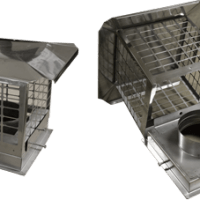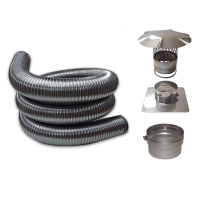With today’s rising energy demands, volatile financial & housing markets and a constant potential of increased living costs looming over our shoulders, catching a financial break anywhere we can as a consumer should be of keen interest to everybody. 90%+ Annual Fuel Utilization Efficiency (AFUE) furnaces may easily provide the solution and can easily off set a household bill or two with all of the energy being saved by this furnace in contrast to the conventional 60-80% AFUE furnace that is more than likely currently in your home even as you read this article. 90%+ AFUE furnaces have a 2 heat exchanger design to avoid wasting heat, in the past the product was problematic when it was first developed in the 90’s, but has since been improved to near perfection today by most manufacturers to be a very reliable product and if sized properly and installed properly will save an incredible amount of money on the utility bill that you can capitalize on year in and year out.
The two heat exchanger design is the key feature that allows a 90%+ AFUE furnace to operate so efficiently. A primary heat exchanger handles the ignition of the furnace and the natural gas fire (propane, kerosene, heating oil or what ever the furnace burns) of the furnace burners. As the burners are engaged inside of the heat exchanger, the heat exchanger gets hot so that when the furnace blower turns on, forced air travels over the hot heat exchanger to allow for heat transfer to occur, sending warm air through your air ducts and to ultimately heat the air in your home. With a conventional 60-80% AFUE furnace that is all that is present for a heat exchanger, but through brilliant engineering furnace manufacturers realized that flue gases always creates hot moisture that is typically wasted out of the flue pipe and so they decided to capture this free energy by designing a better product. So engineers went to work to produce the two heat exchanger furnace and incorporated a secondary heat exchanger that looks like a coil to capture the hot flue gas moisture to re use this heat in a more efficient appliance, rather than wasting this heat out of the flue pipe.
Remarkably after 70 years of relatively little change in the heating market in terms of how a furnace basically operated, a vastly more efficient appliance emerged on the market. Two stage technology emerged as well, where engineers realized that a furnace did not necessarily have to high fire gas at all times to effectively heat your home, due to varying weather outside of your home. The two stage gas valve emerged to where a low fire predominately occurs on temperate (less cold) winter days saving an additional 25-35% on gas consumption and then when the weather gets real cold outside the furnace can engage a high fire to ensure that the appliance can keep up with heating your home only when high fire is truly needed, to ensure that the homeowner gets the best of both worlds; saving money and staying comfortable.
A conventional furnace is missing these features, because the conventional furnace can only fire in one stage and just wastes flue gas moisture out of the flue pipe. The venting of a 90%+ AFUE furnace is typically done with PVC piping material and most often is vented to the exterior side of a home. The 90%+ AFUE furnace burns and exhausts vastly more cleaner gases than a conventional furnace effectively lowering emissions as well, so you can feel good about doing your part in the environment when you have a 90%+ AFUE furnace installed in your home.
Some contractors are afraid to install a 90%+ AFUE furnace in your home due to lack of training and an inability to successfully repair furnaces in the first place. One legitimate complaint and or criticism that was true in the past, that these contractors would make, is that parts were more expensive on a 90%+ AFUE furnace and why on earth would you want an expensive repair bill they would ask. That all came to an end when Rheem manufacturing designed their new line of 95% AFUE 2 stage furnaces. All parts selected to make the Rheem 95% AFUE 2 stage furnace work are of quality durable design, but cost effective to repair after the furnace warranty expires.
The Rheem primary heat exchanger is constructed of stainless steel and is of a tubular design with virtually no seam points present on the part, kind of like a car tail pipe, which rarely breaks. Eliminating seam points on the heat exchanger increases the life span of the part. On the contrary, the Lennox, Carrier, Trane and American Standard heat exchangers are a cheaper clam shell design that is no where near as strong as the tubular designed heat exchanger. The clam shell designed heat exchanger is designed to last a certain amount of years, but once enough time goes by these heat exchangers typically fail due to 4 sides of crimped seams separating the heat exchanger, leading to part failure.
Not only is the Rheem 90%+ AFUE line of furnaces tougher and built with cost effective parts in mind, but they even went as far as ensuring that all Rheem furnaces operate at a vastly lower decibal range making the Rheem furnace the quietest class of furnaces in the residential market today. Carrier, Trane, American Standard and Lennox furnaces will work and if sized and installed properly will last for many years, however when they break, you will surly pay a pretty penny to get them fixed.
When you call out an HVAC company or contractor to perform an in home estimate to install your 90%+ AFUE furnace, make sure that they are evaluating your whole house. Proper furnace sizing will involve an estimator to evaluate wall insulation type, attic insulation type, home exposure, window type, slab type, outdoor landscape, fire places present, duct sizing, how many people occupies the space as well as a few other factors too.
Be leery of the estimator that is in and out of your home in 30 minutes or less, because getting it right during the estimate phase will have a huge effect on achieving maximum efficiency of the furnace and your over all indoor comfort for many years to come. Most of the estimates that reputable heating and air conditioning companies perform may require between 1-2 hours to gather all necessary data, answer customer questions and to write an up front price to do the work.
There are many like minded good companies and contractors out there that conduct themselves that way as well. Your best bet would be to just call out an ACCA member company to perform the estimate, because an ACCA member company will operate professionally, follow higher HVAC standards and receives accredited support in training, up to date trade information and will be up to date with new techniques and standards in the HVAC field. Visit www.acca.org and use the contractor zip code locator to find an ACCA member company near you.







